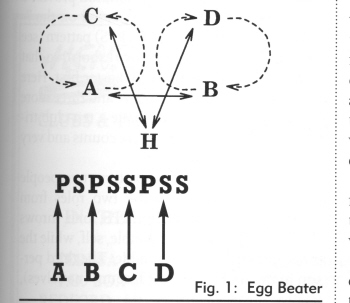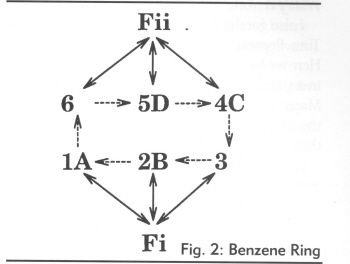|
Mad Passing Patterns BY MARTIN FROST
What
the heck here are some more passing
The
Egg Beater I
learned this pattern from Michael Newton at the Madfest in Madison,
Wisc., this last January. They do some fun club patterns up there.
The Egg Beater involves five people as shown in Fig. 1, with two pairs of jugglers who are continuously rotating around each other (A with C, and B with D). The pattern is not terribly difficult, but you do need to be able to move around relatively quickly while juggling. The fifth person (H - the handle) doesn't move, but feeds the two positions on the end of the beater (where C and D are initially).
The
four beater jugglers all do the same sequence of passes and selves,
though each one starts in a different part of the sequence. A and C do
mirror image movements from what B and D do, as you can see from the
arrows in Fig. 1. The pattern is eight beats long, with 2-count beats
(you could slow the pattern down and use 3-count beats, to enable
passing with both hands). On each beat, two of the five jugglers are
exchanging a pass.
On
the first beat, A and B pass straight across to each other, while D
starts moving backwards and to the left, heading for B's position
from behind. Immediately after that first pass, B heads out a little
forward and to the right, to back into D's initial position. The
second beat has H exchanging a long pass with C, followed immediately
by C backing up and
On
beat three, A and D pass straight across, since D has taken B's
initial position. Following that pass, A moves a little forward and to
the left to back into C's original position. With the fourth beat,
Hand B exchange passes (B is now where D started).
H
ends up passing a 4-count, alternately passing to the two sides at the
end of the beater (C and D positions in Fig. 1). The sequence of
passes and selves for everyone else is PSPSSPSS, as shown in Fig. 1,
where the arrows labeled A through D show where in the cyclical
sequence each of those four jugglers starts. Note that when you're in
the middle of the beater, you pass every other (PSP) straight across,
but while you are moving to the end (to pass with H) and back, you
pass every third (SSPSS).
As
you move around into the end positions (of C and D in Fig. 1), you
should back into the position and be facing H, since that's where your
next pass will go. Don't back up too much before your pass, so that
you're more in the middle of the beater and have a clear line to pass
to H. Then as you move back and around to the middle position, you
want to come in facing straight across, since that's where your next
two passes will go (to two different jugglers).
If
necessary, the exchanges with H can be made easier by having H move a
little bit side to side, always moving away from the side where the
next long pass will go.
The
Benzene Ring This
is another pattern from the Madison Area jugglers. It involves six
jugglers in the formation shown in Fig. 2. As in the Egg Beater, four
of the jugglers are continuously moving, as they alternately face one
of the two feeders and then the other. Of the four, at any given time
two are facing one feeder and two are facing the other.
Each
feeder does a 2-count typewriter feed. In particular, feeder Fi simply
passes to positions 123123..., while at the same time feeder As
you feed the moving feedees, it might be helpful to lead each one a
little. Unfortunately, that means passing inside, which has a risk of
hitting the feedee's self, so don't lead too far, but definitely avoid
outside passes that would make the feedee lean the wrong direction,
inhibiting the normal movement to the right. (You could reverse the
direction of movement of the feedees, having them move to their left.
This makes it very easy to lead them. In this case the feeders would
simply do a reverse typewriter, going down the line from
Meanwhile,
each feedee does a 4-count, passing once from each position
encountered. All the feedees go through their six positions in the
order 654321, over and over. Each feedee moves to the right one
position after each pass, except that if you're already on the right
end (in position 1 or 4), you turn 180 degrees to face the other
feeder, to whom you have to pass immediately after turning.
There
are different ways to do the quick turn. The easy way is simply to
catch your three clubs, stop juggling and turn 180 degrees to your
left (with two in your right hand), ready to pass to the other feeder.
But
to turn without stopping juggling, try the following simple but
elegant turn (suggested by Owen Morse at the recent Isla Vista
festival).
After
your last pass to one feeder, throw a right behind the back to
yourself. As you let go of that club, turn almost 180 degrees to your
left to catch it in your left hand. Do a left self as you catch the
behind-the-back throw, and then pass to your new feeder. The throw
behind the back will get the club where you need to be - you just have
to turn to meet it and to face the second feeder. Turning to your left
involves a shorter turn (actually less than 180) than would a turn to
your right.
If you add two more feedees, each feeder will feed four positions in a typewriter, instead of three, and each feedee will do a 6-count instead of a 4-count. In this case it is much easier to make the turn at the end of the line, since you as a feedee have two more counts to recover from the turn before having to pass. |

